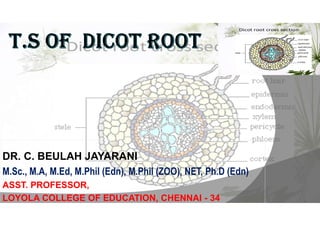
T.s. dicot root
- 1. DR. C. BEULAH JAYARANI M.Sc., M.A, M.Ed, M.Phil (Edn), M.Phil (ZOO), NET, Ph.D (Edn) ASST. PROFESSOR, LOYOLA COLLEGE OF EDUCATION, CHENNAI - 34
- 2. ROOT SYSTEM The root system is the descending (growing downwards) portion of the plant axis. It elongates to form primary or the tap root. It gives off lateral branches (secondary and tertiary roots) and thus forms the root system. It branches through large and deep areas in the soil and anchors the plant very firmly. 7/18/2021 Dr. C. Beulah Jayarani 2
- 3. Contd., The root system of a plant constantly provides the stems and leaves with water and dissolved minerals. When a seed germinates, the first root to emerge is the radicle, or primary root. 7/18/2021 Dr. C. Beulah Jayarani 3
- 4. DICOTS Dicotyledon – Monocotyledon differences MONOCOTS In seeds, two cotyledons (part of the embryo) Usually four or five floral parts (or multiples of these) Usually a netlike array of leaf veins Basically, three pores of furrows in pollen grain In seeds only one cotyledon Usually three floral parts (or multiples of three) Usually a parallel array of leaf veins Basically, one pore or furrow in pollen grain Vascular bundles distributed ground tissue of stem Vascular bundles arrayed as a ring in stem vascular bundle There are two classes of flowering plants, Monocotyledons and Dicotyledons 4
- 5. FUnCtIonS oF Root SYStEM Anchoring: Roots are the reason plants remain attached to the ground. Support: They support the plant body, ensuring that it stands erect. Absorption: Primary function of the roots is to absorb water and dissolved minerals from the soil. 7/18/2021 Dr. C. Beulah Jayarani 5
- 6. t.S oF dICot Root ANATOMY OF DICOT ROOT Epidermis Cortex Endodermis Pericycle Vascular bundles Pith 7/18/2021 Dr. C. Beulah Jayarani 6
- 7. CRoSS SECtIon oF dICot Root 7/18/2021 Dr. C. Beulah Jayarani 7
- 8. EPIdERMIS The word epidermis come from the Greek origin, epi-upon - derma- skin “outer layer of the cell” Role : to protect the cells from the dangers of the outside world. The epidermis consist of loosely packed elongated cells with this walls-cuticle 7/18/2021 Dr. C. Beulah Jayarani 8
- 9. It is the site for water absorption is an extension of epidermal cells. Root hair is made up of unicellular. Root haIR 7/18/2021 Dr. C. Beulah Jayarani 9
- 10. CoRtEX In plants tissue of unspecialized cells lying between the epidermis and vascular tissue. The cortex is made of parenchyma cells. 7/18/2021 Dr. C. Beulah Jayarani 10
- 11. Structure Simplest and thin walled cell, fundamental tissue of plant body. Shape - isodiametric or polygonal, thin walled with prominent nucleus and vacuolated cytoplasm. Functions of parenchyma: storage of reserve food materials & mechanical support. PaREnChYMa 7/18/2021 Dr. C. Beulah Jayarani 11
- 12. ENDODERMIS The word endodermis is Latin origin , endo-within dermis – skin The endodermis is the cylindrical boundary of vascular tissue-single layer. Functions : regulate the water and other substance that get into the plant. 7/18/2021 Dr. C. Beulah Jayarani 12
- 13. 7/18/2021 Dr. C. Beulah Jayarani 13
- 14. PERICYCLE It is a thin layer of plant tissue. It is present between the phloem and endodermis. 7/18/2021 Dr. C. Beulah Jayarani 14
- 15. VaSCULaR BUndLE It is a strand of conducting vessels in the root of a plant, typically with phloem on the outside and xylem on the inside. They are also called as “fascicle” Vascular bundle consists of two main parts. xylem: the water conducting tissue. phloem: the food conducting tissue 7/18/2021 Dr. C. Beulah Jayarani 15
- 16. xylem: components: tracheids, vessels, xylem fibre and xylem parenchyma Xylem protoxylem metaxylem 7/18/2021 Dr. C. Beulah Jayarani 16
- 17. Phloem: Components of phloem: sieve cells/sieve tubes companion cells, phloem parenchyma, phloem fibres. Companion cells also present in the phloem. 7/18/2021 Dr. C. Beulah Jayarani 17
- 18. PIth It is soft and spongy. New pith growth appear white but as it matures it usually turns brown. 7/18/2021 Dr. C. Beulah Jayarani 18
- 19. dIFFEREnC BEtWEEn MonoCot and dICot Root 7/18/2021 Dr. C. Beulah Jayarani 19
- 20. dIFFEREnC BEtWEEn MonoCot and dICot Root Dicot root Monocot root The cortex area is narrow. Pericycle: Gives rise to cork cambium, parts of the vascular cambium, and lateral roots Has a limited number of Xylem and Phloem Xylem is Angular or Polygonal Pith is Absent or very small and undeveloped Cambium is Present and formed by the Conjunctive parenchyma The cortex region is wide. Pericycle: Gives rise to lateral roots only Has a higher number of Xylem and Phloem Xylem isRound or Oval Pith isLarger and well developed Cambium is absent 7/18/2021 Dr. C. Beulah Jayarani 20
- 21. REFEREnCE “SCIENCE READER” Tamil Nadu text book NCERT Books Google images 7/18/2021 Dr. C. Beulah Jayarani 21